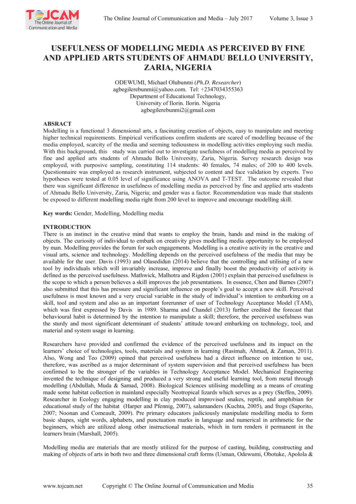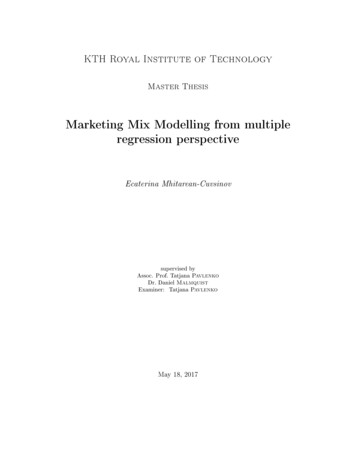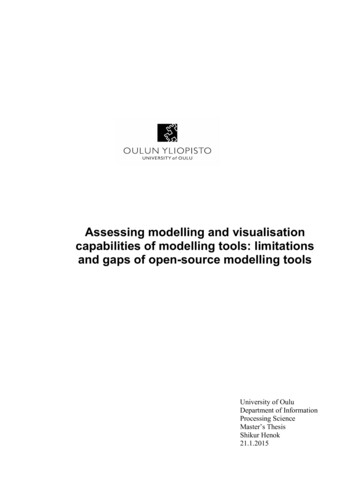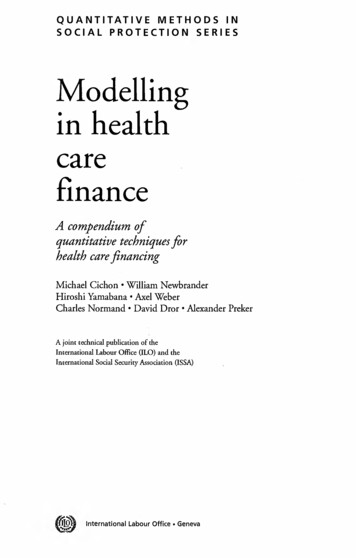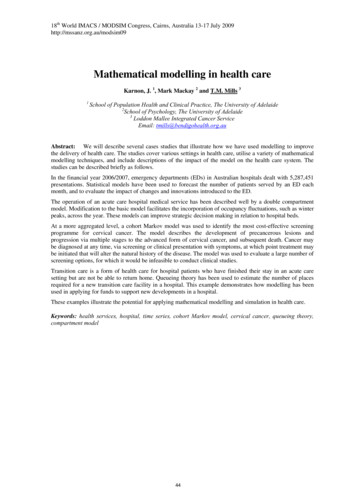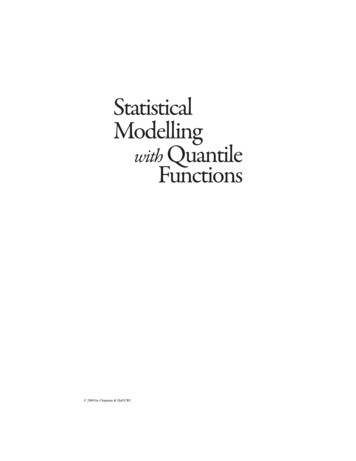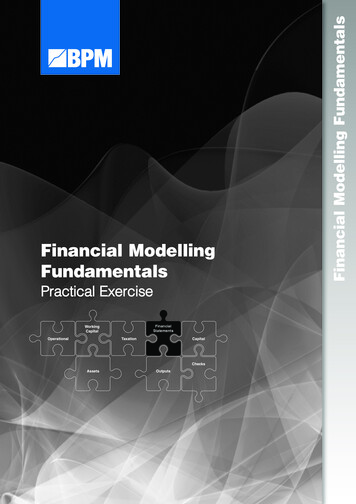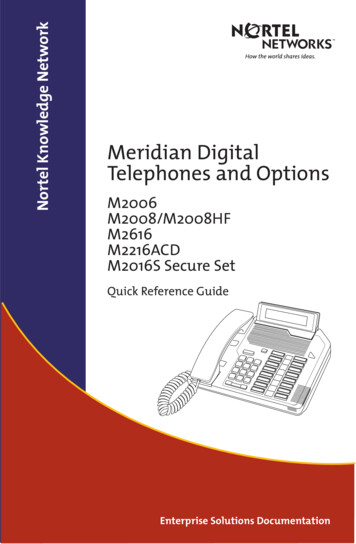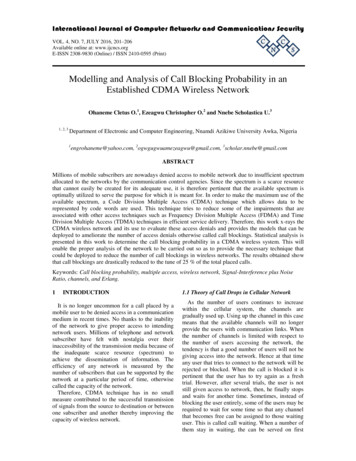
Transcription
International Journal of Computer Networks and Communications SecurityVOL. 4, NO. 7, JULY 2016, 201–206Available online at: www.ijcncs.orgE-ISSN 2308-9830 (Online) / ISSN 2410-0595 (Print)Modelling and Analysis of Call Blocking Probability in anEstablished CDMA Wireless NetworkOhaneme Cletus O.1, Ezeagwu Christopher O.2 and Nnebe Scholastica U.31, 2, 3Department of Electronic and Computer Engineering, Nnamdi Azikiwe University Awka, Nigeria1engrohaneme@yahoo.com, 2ogwgugwuamezeagwu@gmail.com, 3scholar.nnebe@gmail.comABSTRACTMillions of mobile subscribers are nowadays denied access to mobile network due to insufficient spectrumallocated to the networks by the communication control agencies. Since the spectrum is a scarce resourcethat cannot easily be created for its adequate use, it is therefore pertinent that the available spectrum isoptimally utilized to serve the purpose for which it is meant for. In order to make the maximum use of theavailable spectrum, a Code Division Multiple Access (CDMA) technique which allows data to berepresented by code words are used. This technique tries to reduce some of the impairments that areassociated with other access techniques such as Frequency Division Multiple Access (FDMA) and TimeDivision Multiple Access (TDMA) techniques in efficient service delivery. Therefore, this work x-rays theCDMA wireless network and its use to evaluate these access denials and provides the models that can bedeployed to ameliorate the number of access denials otherwise called call blockings. Statistical analysis ispresented in this work to determine the call blocking probability in a CDMA wireless system. This willenable the proper analysis of the network to be carried out so as to provide the necessary technique thatcould be deployed to reduce the number of call blockings in wireless networks. The results obtained showthat call blockings are drastically reduced to the tune of 25 % of the total placed calls.Keywords: Call blocking probability, multiple access, wireless network, Signal-Interference plus NoiseRatio, channels, and Erlang.1INTRODUCTIONIt is no longer uncommon for a call placed by amobile user to be denied access in a communicationmedium in recent times. No thanks to the inabilityof the network to give proper access to intendingnetwork users. Millions of telephone and networksubscriber have felt with nostalgia over theirinaccessibility of the transmission media because ofthe inadequate scarce resource (spectrum) toachieve the dissemination of information. Theefficiency of any network is measured by thenumber of subscribers that can be supported by thenetwork at a particular period of time, otherwisecalled the capacity of the network.Therefore, CDMA technique has in no smallmeasure contributed to the successful transmissionof signals from the source to destination or betweenone subscriber and another thereby improving thecapacity of wireless network.1.1 Theory of Call Drops in Cellular NetworkAs the number of users continues to increasewithin the cellular system, the channels aregradually used up. Using up the channel in this casemeans that the available channels will no longerprovide the users with communication links. Whenthe number of channels is limited with respect tothe number of users accessing the network, thetendency is that a good number of users will not begiving access into the network. Hence at that timeany user that tries to connect to the network will berejected or blocked. When the call is blocked it ispertinent that the user has to try again as a freshtrial. However, after several trials, the user is notstill given access to network, then, he finally stopsand waits for another time. Sometimes, instead ofblocking the user entirely, some of the users may berequired to wait for some time so that any channelthat becomes free can be assigned to those waitinguser. This is called call waiting. When a number ofthem stay in waiting, the can be served on first
202O. Cletus O. et. al / International Journal of Computer Networks and Communications Security, 4 (7), July 2016come first serve bases as soon as a channel is free.This phenomenon is known as queuing. Queuing isone of the processes in wireless network where thelimited resources are efficiently utilized to serve themobile users at a particular time. After thepredetermined period of time, and if there is still noavailable channel to support other users in thequeue, the user is also blocked. The theory ofqueuing in cellular network was somehow notnecessarily needed by some users because it ismore annoying to block a call after queuing thanblocking it at the first instance. Call blockings incellular networks can be attributed to insufficientnumber of channels in the system with relative tothe number of users trying to access the networksimultaneously. Hence efficient channel utilizationshould be the cardinal focus of every networkprovider to contain the teaming number ofsubscribers trying to access the network for theirsatisfaction on the services being provided.On the other hand, calls may be admitted into thenetwork, but may be lost before the calling partyconcludes the call. This lost in the calls in session isknown as call drops. Call drops can be as a result of(i) Low signal strength being received by themobile user as a result of the distance of theuser from the transmitting base station,(ii) The poor quality of the communicationchannel due to noise and interference,(iii) The movement of mobile user from onecell to another cell, which can be regarded ascall dropping due to unsuccessful handoff,e.t.c.2REVIEW OF RELATED LITERATURESThere are several works in which networkperformance in cellular network have been studied.In particular, how call drops and their probabilityare related to traffic parameters such as channelholding time, call drop intensity, handover rate etc.Most of these previous works assume the classicalteletraffic theories, which assumes negativeexponential distribution to model the channelholding time in large and single cell system for thesake of conveniences and tractability.[2] Attempted in describing the channel holdingtime by the negative exponential distribution and heshows that the channel holding time can be seen asdirectly dependent on two other exponentialprocess, namely: the total calls duration and thecrossing boundaries. Also in their own research, [3]also assume the negative exponential distribution ofchannel holding time is limited to voice services,however the second generation and beyond cellularnetwork provides services such as voice, data,video etc. Hence the exponential hypothesis is notappropriate.Also the channel holding time has been shown tofit lognormal distribution by [4] when they studiedthe call drop probability in a well establishedcellular Network. They were able to develop a newsimple model to relate drop call probability withtraffic parameters in the well established cellularnetwork where handover failure becomesnegligible. Handover failure is never a negligiblefactor in the network operating in Nigeria.Furthermore, various other models have beenproposed by many authors, such as the Sum ofhyper-exponential distribution and the generalizedGamma distribution models. [5] used thegeneralized Gamma distribution to model the cellresidence time. Unfortunately, the generalizedgamma distribution leads to the loss of Markovianproperty in the resulting queuing model of thecellular network, which makes the resultingqueuing system intractable. The author alsomodelled the cell residence time as SOHYP (sumof hyper exponential) random variable. Theadvantage of using SOPHY distribution is thepreservation of the Markovian property in thequeuing network model.It had been shown that SOHYP model can beturned to have the coefficient of variation of the cellresidence time less than, equal to and greater thanunity, while the exponential and Erlang distributionmodel for cell residence time only applies to casewhere the coefficient of variation are less thanunity. However, it is not known whether theSOHYP models have the capability of universalapproximation.More so, many other papers have studied calldrop probability, one of such works is that whichwas done by [3]. In this work, drop call probabilitywas analyzed with the classical assumption ofexponential distribution for the channel holdingtime. In particular, it put emphasis on handover andits effects on performance. Handover is consideredthe main ease for call dropping.[6] studied the performance of a cellular networkby considering more general distribution for calland the channel holding times. Analyticalexpression for drop call probability is obtainedshowing the effect of more realistic assumption onsystem behaviour.In his own contribution, [7] studied the influenceof handover on mobile performance is analyzedconsidering different pattern for mobility. They alsostudied handover and call dropping in mobilecellular system calls, that is, multiple types of
203O. Cletus O. et. al / International Journal of Computer Networks and Communications Security, 4 (7), July 2016services is assumed. Each class has different callholding and cell residence times.In [8] estimation, the drop call probabilityconsidering a wireless, multimedia network,adaptive bandwidth allocation algorithm isexploited to improve system performance and toreduce in particular, handover-blocking probability.Although the describe models were very useful inthe early phase of mobile network deployment, theyare not very effective in a well-established cellularnetwork. In such a system, network-performanceoptimization is carried out continuously by mobilephone operators.3 MODELLING CALL BLOCKINGPROBABILITY IN CDMA SYSTEMThe probability that a new call is blocked given by[1] whereis the number of speech channels percell, is the number of calls in progress andisthe average offered traffic in units of users. This iscalled Erlang B formula which was evaluated fordifferent values of channels in ascending orderusing matlab. The corresponding values of callblocking probabilities are tabulated against thenumber of channels as shown in Table 1.Table 1: Call blocking probabilities evaluated from channelcapacityS/NPr(Blockingprobability)Number of 0.80541500The art of any network design is, to a largeextent, to predict the call behaviours of users, andderive the physical infrastructure (i.e., availablenumber of speech channels) that guarantees anacceptable grade of service. Several factorsinfluence this design process:The number and duration of calls on the timeof the day. A busy hour (usually around 10.00hour and 16.00 hour) can now be defined as thehour that determines the required optimumnetwork capacityThe spatial distribution of users is time variant:while business districts (city centres) usuallyexperience a lot of activity during the day time,suburbs and entertainment districts experiencemore traffic during the night time,Changing user habits are also related to theoffering of new service (e.g., data connections)and new pricing structures (e.g., free calls inthe evening hours). The strategy of selling“minute accounts” that have to be used up eachmonth also leads to longer talk times than apricing strategy of charging per minute.Based on statistical knowledge of user habits, asystem can be designed with certain probability thatallows a given number of users per cell to make acall. If, through a statistical fluke, all users wantmake a call simultaneously, some of the calls willbe blocked. For the computation of the rate ofblocking (blocking probability) of a simple system,the following assumptions are made: The times when the calls are placed arestatistically independent’The duration of calls is an exponentialdistributed random variable,If a user is rejected, his next call attempt istreated as a new user irrespective of hisprevious attempts. In other words, the blockeduser retries immediately. After being blockedseveral times within a short time interval, heusually gives up and places the next call after amuch longer waiting time. Such a system canbe represented by Erlang B system, andprobability of call blocking is given in equation1. Rewriting the equation gives Simulation of the wireless system gives graphicalrepresentation of the relationship between the callblocking probability and offered traffic as shown infigure 4.4. It can therefore be observed that the ratioof required channels to offered traffic is very high ifis small, especially for low required blockingprobabilities. For example, for a required blockingprobability of 1%, the ratio of possible offeredtraffic to available channel is less than 0.1 if
204O. Cletus O. et. al / International Journal of Computer Networks and Communications Security, 4 (7), July 2016. Ifis very large, then the ratio is only less thanunity, and becomes almost independent of therequired blocking probability. Assuming again arequired blocking probability of 1%, the ratio ofpossible offered traffic to available channels isabout 0.9 forAlternative model assumes that any user that isnot immediately assigned a channel is transferred toa waiting loop, and assigned a channel as soon as itbecomes available. The probabilitythat a useris put on hold (delay) according to [4] is:) (and the average waiting time(whereis:)is the average duration of the call.The probability that a call can be placed, and isnot blocked, is an important part of service quality:remember that quality of service is defined as 100%minus the percentage of blocked calls, minus tentimes the percentage of lost calls. But therequirements for service quality differ vastly fordifferent wireless services. One of the mainindicators of service quality is speech services andfile transfer speed for data services. Speech qualityis measured by the mean opinion score (MOS)which represents the average of a large number ofhuman assessments about the quality of receivedspeech (listening). The speed of data transmissionon the other hand is simply measured inbits/second- obviously a higher speed is better.An even more important factor is the availabilityof a service. For cell phones and other speechservices, the service quality is often computed asthe compliment of “fraction” of blocked calls plusten times the fraction of dropped calls (blockedcalls encompass all failed call attempts, includingthose that are caused by insufficient signal strength,as well as insufficient network capacity). Thisformula takes into account that the dropping of anactive call is more annoying to the user than theinability to make a call at all. However, foremergency services and military applications,service quality is better measured as thecompliment of “fraction of blocked calls plusfraction of dropped calls”. Also during emergencysituation, the inability to make a call is as annoyingas the situation of having a call interrupted.A related aspect is also the admissible delay(latency) of the communication. For voicecommunications, the delays between the time whenone person speaks, and the other hears the message,must not be longer than about 100ms. For suchtransmitted signal, it must be noted that the firsttransmitted data are the ones that would be madeavailable to the receiving user first. Hence for datafiles, the acceptable delays can be usually longer,and the sequence with which the data arrive at thereceiver is not critical (for example, whendownloading e-mail from a server, it is notimportant whether the first or the seventh of the email is the first to arrive). However, there are somedata applications where small latency is vital; e.g.,for control applications, security and safetymonitoring e.t.c.In an FDMA system, a large system load can leadonly to blocked calls, but not lost calls, as long aseach user stays in the coverage areas of the user’sbase station. How-ever, calls can be dropped whena user with an ongoing call tries to move to adifferent cell whose BS is already fully occupied. Afully loaded system increases interferences withneighbouring cells, thus making the links in thatcell more sensitive to fluctuations in signalstrength, and possibly increasing the number ofdropped calls due to insufficient signal-tointerference plus noise ratio (SINR).It can therefore be found that the number of usersthat can be accommodated with a given QoSincreases faster and linearly with the number ofavailable speech channels. The difference betweenactual increase and linear increase is called thetrunking gain. From a technical point of view, it isthus preferable to have a large pool of speechchannels that serves all users. If only one operatorowns the entire spectrum, this approach could befulfilled. But due to political reasons (pricing andmonopoly) this cannot be adopted.4SIMULATION AND RESULTSThe models obtained from the analysis in thispaper are simulated to see the behaviour of thequality of service (QoS) parameters with respect tothe number of users and also in relation to theavailable channels in a CDMA wireless system.This simulation was achieved using Matlab. FromFig. 1, it can be deduced that as the number ofchannels increases, the probability that a user isdenied access to the network in terms of call drop isdrastically reduced. It can also be inferred from thefigure that at certain instant of the number of
205O. Cletus O. et. al / International Journal of Computer Networks and Communications Security, 4 (7), July 2016communication channels available, there is no morecall drops since enough channels are available forcommunication purposes.Besides, Fig. 2 shows how there are delays inmobile network as a result of increase in thenumber of traffic and insufficient number ofchannels in CDMA network. If enough channel isprovided, several users should be connected to thenetwork and also reduce the delays due to trafficcongestion which may have arisen if insufficientchannels were not provided. It shows that the callblockings vary exponentially with the number users(or offered traffic) in the network. Here, it isevident that the offered traffic determines the rateof blocking probability in CDMA system.especially CDMA system in the mist of the scarceresource (speech channels).The network has been modelled in terms of calldropping probability. The call delays and callprobability are compared with relative to number ofusers. It was discovered that the number of calls(users) determines the quality of the signals interms of delay probability and call drop probability.Since the communication channel is scarce, itincreases the interferences with neighbouring cellsthereby making the links more sensitive tofluctuations in signal strength. It therefore increasesthe number of drop calls as a result of insufficientsignal-to-interference plus noise ratio (SINR).Hence, this paper has provided the models thatcan be used to minimize the call drops in thenetwork thereby improving the QoS for mobileusers.6Fig. 1. Plot of Call blocking probability Vs Number of ChannelsFig. 2. Plot showing call delay probability versus Offered traffic5CONCLUSIONIn the life of mobile communication users, it isevident that call denials and poor quality of serviceshave been the bane of recent woes experienced inrecent time. Therefore, this work has tried toproffer unwavering solution to the problem of calldrops in wireless communication networksREFERENCES[1] RappaportS,Theodore,“WirelessCommunications, Principles and practice”,Second Edition, Prentice Hall of India, 2008.[2] Roch A.Guerion, “Channel Occupancy TimeDistribution in a Cellular Radio System”, IEEETrans. Veh. Tech.Vol 35, No.3, PP 89-99,1987[3] Hong D. and Rappaport T.S., “Traffic Modeland Performance Analysis for Cellular MobileRadio Telephone System with Prioritized andNon-prioritized Handoff Procedure”, IEEETrans.Veh., Vol.35, No. 3 pp 77-92,1986[4] Gennario Boggia, PietroCamarda, andAlessandro D’Alconzo, “Modelling of CallDropping in Well Established CellularNetwork” EURASIP journal on ticle ID:17826,PP 11. 2007.[5] Zonoozi M.M, Dassanayake P., “User MobilityModelling and Characterization of MobilityPattern”, IEEE Selected Area Comm. Vol.15.No.7 Pp 1239-1252, Oct 1997.[6] Yuguang Fang, Imrich Chlamtac, “Tele-trafficAnalysis and Mobility Modelling of PCSNetwork”, IEEE Trans.Comm. Vol 47 No.7,July 1999.[7] Nasser N., “Enhanced Blocking Probability inAdaptive Multimedia Wireless Network”, InProceedingOfThe25thIEEEIPCCC.Vol.2006,Pp 647-657,USA April 2006.[8] Honda Khedher, Frbrice Valois, “ChannelHolding Time Characterization in Real GSMNetwork”, CITI Lyon France, 2004.
206O. Cletus O. et. al / International Journal of Computer Networks and Communications Security, 4 (7), July 2016AUTHOR PROFILES:Cletus Ogbonna Ohaneme: was born in Nanka inAnambra State of South-East Nigeria. He holdsB.Eng. in Electrical/Electronic Engineering,M.Eng. in Electronic and CommunicationEngineering and Ph.D. in CommunicationEngineering from Enugu State University ofScience and Technology (ESUT) Enugu, Nigeria in1994, 1998 and 2012 respectively. He is presently alecturer in the Department of ElectronicEngineering Nnamdi Azikiwe University, AwkaNigeria. Besides, he is a member of severalprofessional bodies including Nigeria Society ofEngineers (NSE), Nigerian Institution of Electricaland Electronic Engineers (NIEEE), Council for theRegulation of Engineering in Nigeria (COREN) asa Registered Engineer, and InternationalAssociation of Engineers (IAENG). His researchinterest is on Wireless Communication Networksand Spectrum Management.E-mail: engrohaneme@yahoo.com &co.ohaneme@unizik.edu.ngChristopher Ogwugwaum Ezeagwu: is currentlya lecturer in the department of Electronic andComputer Engineering Nnamdi Azikiwe UniversityAwka Nigeria. He hails from Ezi, Aniocha LocalGovernment Area of Delta South-South region ofNigeria. He holds B.Eng. in candCommunication Engineering from Enugu StateUniversity of Science and Technology (ESUT)Enugu, Nigeria in 1986, and 2008 respectively. Heis presently a doctoral student with special interestin Communication Engineering in the Departmentof Electrical/Electronic Engineering ESUT, Enugu,Nigeria. Besides, he is a member of severalprofessional bodies including Nigeria Society ofEngineers (NSE), Nigerian Institution of Electricaland Electronic Engineers (NIEEE), Institute ofElectrical Electronic Engineers (IEEE), Council forthe Regulation of Engineering in Nigeria (COREN)as a Registered Engineer, and InternationalAssociation of Engineers (IAENG) among others.His research interest is on Optic FibreCommunication Systems.E-mail: ogwgugwuamezeagwu@gmail.comScholastica Ukamaka Nnebe: is currently alecturer in the department of Electronic andComputerEngineering,NnamdiAzikiweUniversity Awka, Nigeria. She holds B.Eng. degreein Electrical/Electronic and Computer Engineering,M.Eng. degree in Electronic and CommunicationEngineering and Ph.D degree in CommunicationEngineering from Nnamdi Azikiwe UniversityAwka, Nigeria in 2006, 2009 and 2013respectively. She hails from Umuonaga Awka,Awka South Local Government of Anambra State,Nigeria. Besides, she is a member of severalprofessional bodies including Nigeria Society ofEngineers (NSE), Nigerian Institution of Electricaland Electronic Engineers (NIEEE), Council for theRegulation of Engineering in Nigeria (COREN) asa Registered Engineer, International Association ofEngineers (IAENG) and Institution of Electricaland Electronic Engineers (IEEE). Her researchinterest is on Wireless Sensor Networks andCommunications Systems.E-mail: scholar.nnebe@gmail.com orsu.nnebe@unizik.edu.ng
Table 1: Call blocking probabilities evaluated from channel capacity S/N Pr(Blocking probability) Number of channels 1 0.8902 100 2 0.8422 200 3 0.8276 300 4 0.8081 1000 5 0.8054 1500 The art of any network design is, to a large extent, to predict the call behaviours of users, and
